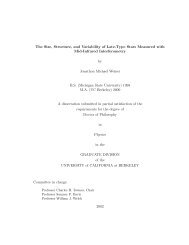Problem Set #3 1. Problem 19.5 (a) Assuming for simplicity that ...
Problem Set #3 1. Problem 19.5 (a) Assuming for simplicity that ...
Problem Set #3 1. Problem 19.5 (a) Assuming for simplicity that ...
You also want an ePaper? Increase the reach of your titles
YUMPU automatically turns print PDFs into web optimized ePapers that Google loves.
<strong>Problem</strong> <strong>Set</strong> <strong>#3</strong><strong>1.</strong> <strong>Problem</strong> <strong>19.5</strong>(a) <strong>Assuming</strong> <strong>for</strong> <strong>simplicity</strong> <strong>that</strong> Earth is a sphere of constant density, compute therate of change in rotation angular momentum of Earth due to the tidal influenceof the Moon. Is the change positive or negative?(b) Treating the Moon as a point mass, estimate the rate of change in orbital angularmomentum of the Moon. Is this change positive or negative?(c) Comparing your crude answers to parts (a) and (b), what can you say about thetotal angular momentum of the Earth-Moon system over time?2. <strong>Problem</strong> 19.6(a) Make a rough estimate of how long it will take <strong>for</strong> Earth’s rotation period toreach 47 days, at which time it will be synchronized with the Moon’s orbitalperiod.(b) Based on what you know about the evolution of our Sun, will future inhabitantsof Earth ever get the opportunity to see the Earth-Moon system in completesynchronized (Earth always keeping the same “face” toward the Moon)? Whyor why not?3. <strong>Problem</strong> 19.7(a) Using Kepler’s laws, estimate the distance of the Moon from Earth at some timein the distant future when the Earth-Moon system is completely synchronizedat 47 days.(b) As seen from Earth, what will the anglular diameter of the Moon be at this time?(c) <strong>Assuming</strong> <strong>that</strong> the Sun’s diameter is the same as the present-day value, would atotal eclipse of the Sun be possible? Why or why not?(d) At the distance calculated in 19.7(a), what is the ration of the tidal <strong>for</strong>ces on theEarth due to the Moon and the Sun. Which will have a larger influence on theEarth’s tides?4. <strong>Problem</strong> 19.10 Using the data in Appendix C, estimate the Roche limit <strong>for</strong> the Mars-Phobos system. Phobos’s mean density is 2000 kg m −3 and it orbits at a distance of9.4 × 10 6 m. Explain the suggestion <strong>that</strong> Mars may develope a small ring system inthe future.1
5. <strong>Problem</strong> 19.10 Below is a plot of the water level over the course of February 1st <strong>for</strong>a beautiful beach in Pago Pago.(a) Why are there two peaks and two troughs over the course of one day?(b) Sketch a similar plot of the water level <strong>for</strong> February 15th. Nothing fancy here,but be sure to explain how you came up with the maximum and minimum heightsand at what times they occur in your plot.2












![Problem #1 [Structure Formation I: Radiation Era]](https://img.yumpu.com/37147371/1/190x245/problem-1-structure-formation-i-radiation-era.jpg?quality=85)



